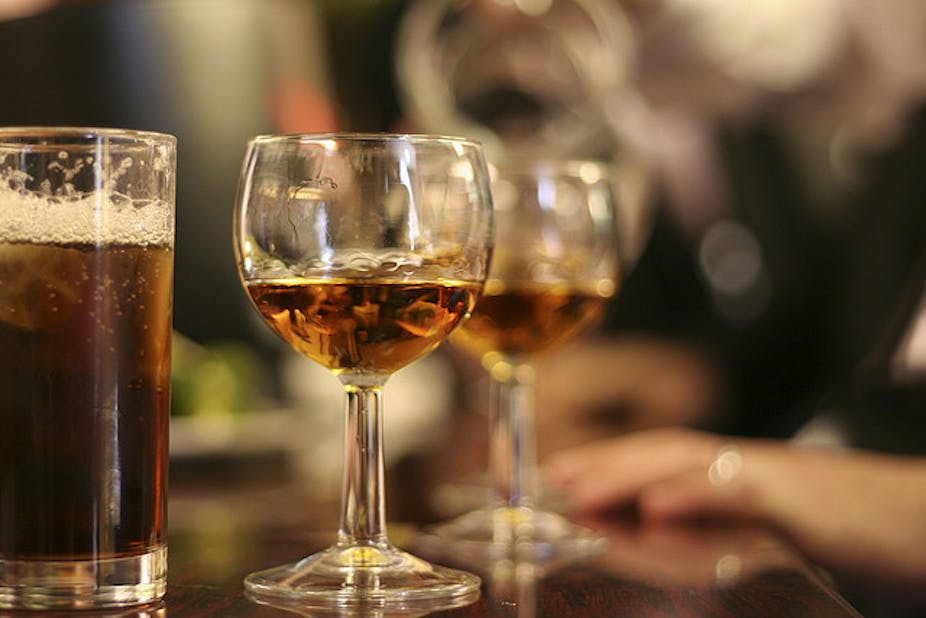We all know that too much booze is bad for our health. Alcohol has been linked to 60 different medical conditions and almost 3,500 deaths a year in Australia, mostly from long-term alcohol abuse, accidents and cancers. Excessive consumption of alcohol and binge drinking is now a key public health issue in Australia.
But while the National Health and Medical Research Council recommends Australian men and women drink no more than four standard drinks on any single occasion, and limit average daily consumption to two standard drinks, recent studies in the United Kingdom and Australia have found that consumers are extremely poor at judging both the number of drinks they consume and the volume of alcohol in each drink.
There’s no doubt that a raft of measures are needed to promote the safe use of alcohol: taxation, education, cuts to industry ties and regulations around alcohol advertising. But consumers also need a way of immediately and accurately judging their consumption level. The solution? A smart card system to track alcohol consumption.
In the cafeteria at my work, Kwansei Gakuin University in Japan, every item of food and drink has its nutritional information stored on a database. When I take my tray of selections to the register, this information is accessed and a total nutritional profile of my meal is printed on the lower half of my receipt. Values for things such as sodium, carbohydrates, fibre, fat and protein are shown. These figures are also shown as a percentage of recommended daily intake.
We have yet to conduct thorough research on the impact on staff and student health, but anecdotal evidence suggest that individual consumption patterns are moving towards healthier levels than before. Information is driving better choices.
In 2008, an electronic system was introduced in Japan to help regulate the sale of tobacco products. The TASPO card is an smart card card similar to Melboune’s Myki or London’s Oyster system and it acts as a proof-of-age card for the purchase of tobacco products from vending machines. The roll out of TASPO was largely trouble-free and it has been widely taken up in Japan.
By combining these two technologies, and making some simple, yet fundamental changes to the way alcohol is sold in Australia, it would be possible to create a national smart card system that could provide consumers with detailed information about their own levels of consumption and help individuals reduce their alcohol intake.
The system could be rolled out in three stages. Firstly, TASPO-type photographic proof-of-age cards would be legally required for all purchases of takeaway alcohol nationwide. It could be incorporated into a driver’s licence or be a stand-alone card. Purchasers would simply show their card to the clerk, then tap it on a smart card reader linked to the store’s scanner to record the details of their purchase.
Consumers would receive an email, SMS or paper statement once a month with a record of their total purchases for the period, along with details such as total tax paid, total calorie count, times and dates of purchases, comparisons with previous periods and, importantly, comparisons of their purchases with national recommended intakes. This information could also be accessed immediately via a website.

The second stage would be more technically challenging and would require the card to be presented for all alcohol purchases. Presenting your card each time you buy a beer in a pub or have a glass of wine at the opera might seem excessive but people have rapidly gotten used to sliding their credit cards across the bar, ditto for EFTPOS.
In fact there would be nothing stopping us from incorporating an optional electronic payment system into the card to make it more attractive. It may not be 100% accurate, but at this point consumers would have a near-total picture of their alcohol purchases for any given period.
Guarantees would need to be put in place that the information would only be made available to the individual, not to government, employers or insurance companies.
The third stage in the program would be more controversial, but potentially the most powerful modifier of behaviour. Using data from the card system, a sliding scale of taxes could be introduced. The first five units of alcohol purchased, for example, could be tax free. The next five would attract a tax, say A$1 per unit. The next five would attract a higher tax, say A$2 per unit, and so on. The more alcohol you purchase, in any form, at any time within the statement period, the higher tax you pay.
The speed of the increase could be altered for different age groups, income brackets or locations. It could be automatically ramped-up for individuals convicted of alcohol-related offences. People would be reluctant to purchase alcohol for others because it would increase their own tax burden for subsequent purchases.
On a night out, drinks would become progressively more expensive. Loading up on alcohol before you go out wouldn’t help, as the system would take into account the takeaway purchases you’d made earlier. The morning after, you could log on to see exactly why you have a three-alarm hangover and how much damage it did to your body and to your wallet.
Yes, you could game the system, but you’d have to put a fair bit of thought into it. And there’s the rub. Every drink, every purchase would encourage people to think about the consequences of their consumption, if only for a moment or two.
Should policymakers consider a smart card for tracking alcohol consumption? Share your comments below.

